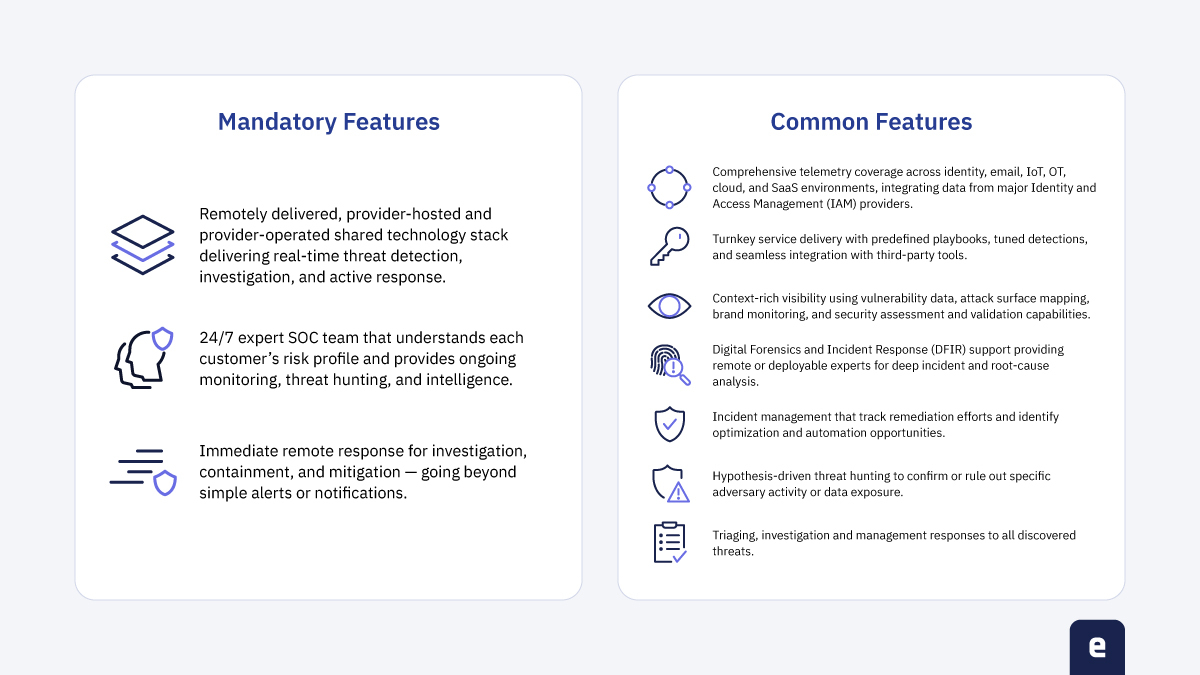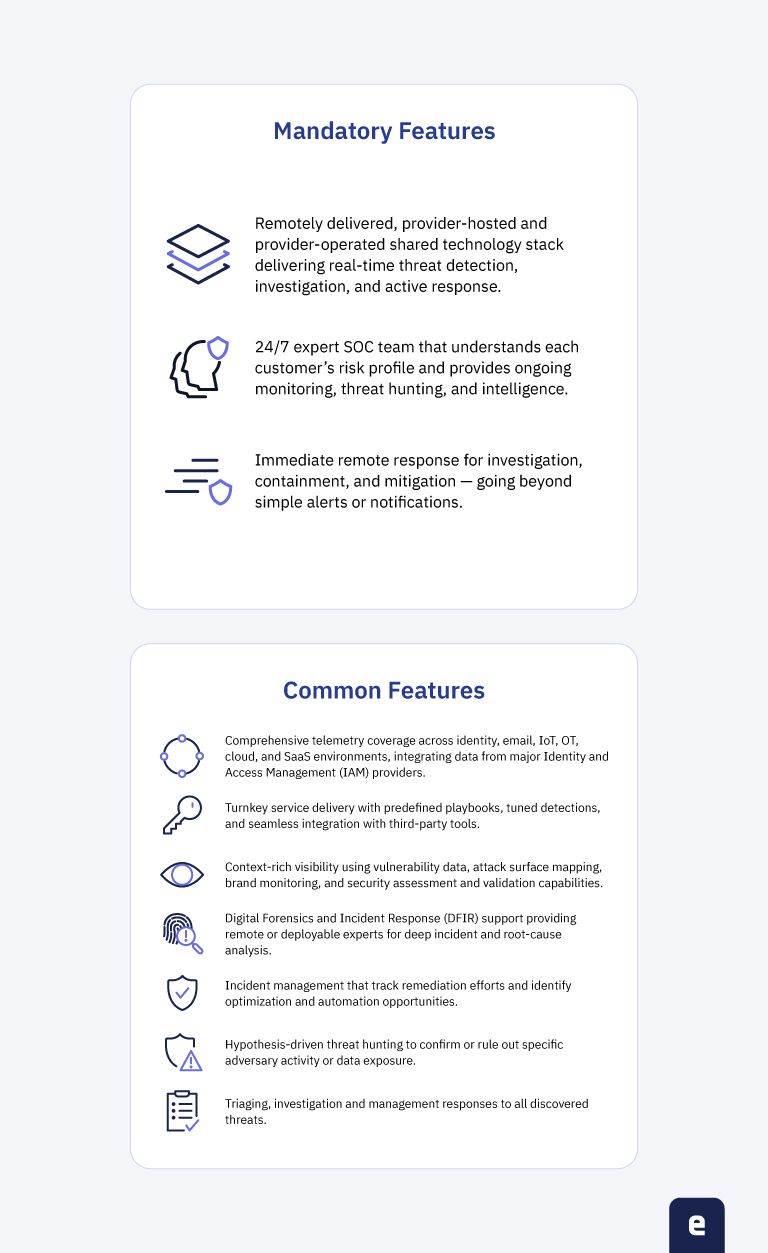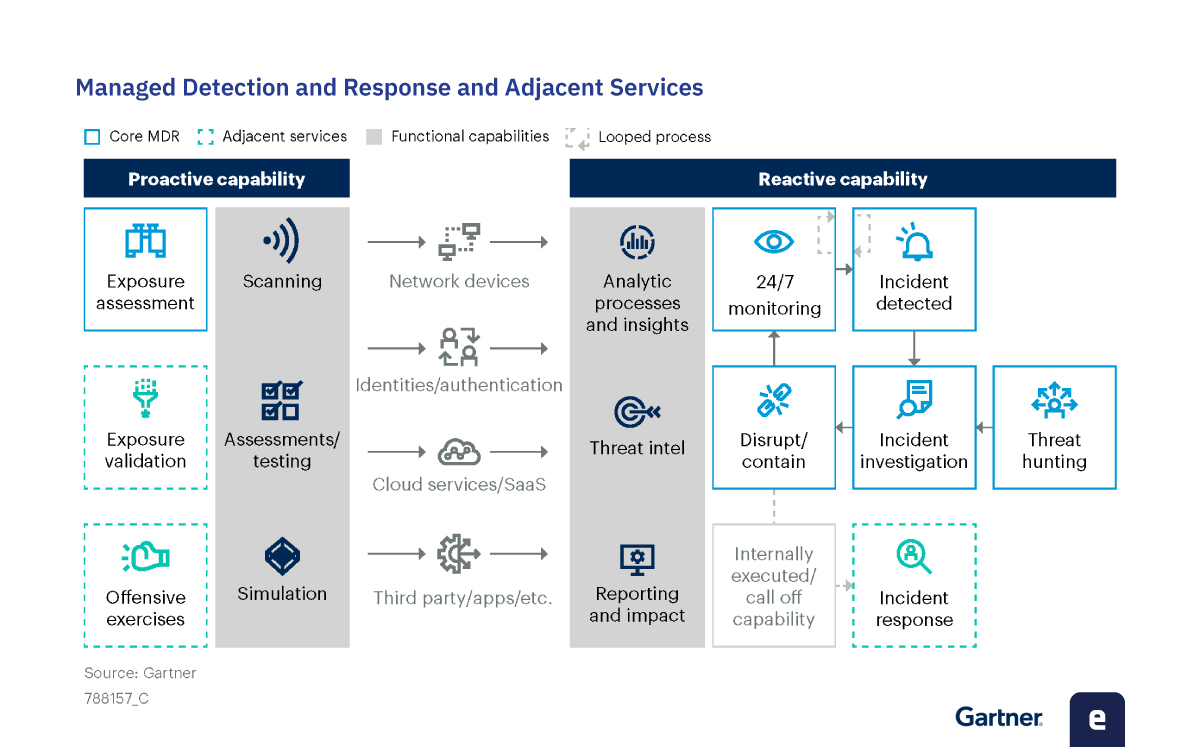Download the 2025 Gartner® Market Guide for Managed Detection and Response Services Now
Managed detection and response GLOSSARY
What is the MDR Gartner Magic Quadrant and Market Guide?
October 9, 2025 | 10 MINS READ
The Managed Detection and Response (MDR) market is growing rapidly, with some reports projecting growth of up to 9.5 billion by 2028. In this saturated market, choosing the right provider to secure your organization can be challenging. Analyst research and reports, like the Gartner Market Guide for Managed Detection and Response Services and the MDR Gartner Magic Quadrant, play a crucial role in helping you evaluate security vendors.
These reports provide a comprehensive evaluation of the MDR market, key trends, and emerging technologies, allowing you to assess security vendors and choose the one which best aligns with your organization’s needs.
What is Gartner?
Gartner is a well-known research and consulting firm that provides analyses and advice on innovative technologies. Gartner helps organizations make informed decisions about technology-related matters by publishing research, offering consulting services, developing proprietary tools, and organizing conferences. Through this research and insights, Gartner helps organizations across various industries understand the latest trends in technology, develop technology strategies, identify and deploy the right technologies for their organizations and evaluate technology providers.
Among various areas of expertise, Gartner is known for publishing high-quality research and guides about cybersecurity technology. Gartner’s cybersecurity research aims to help CISOs effectively manage cyber risk in the evolving cyber threat landscape. In doing so, Gartner equips security leaders with the latest insights, expert advice, and practical tools to achieve their mission-critical priorities.
The Market Guide for Managed Detection and Response by Gartner
Gartner defines MDR as a service that provides customers with remotely delivered security operations center (SOC) functions, allowing them to rapidly detect, analyze, investigate and actively disrupt and contain threats.
The Market Guide for Managed Detection and Response Services is one of the most popular assets among Gartner’s extensive portfolio of cybersecurity research. This report provides a comprehensive overview of the Managed Detection and Response market landscape. It highlights key trends, challenges, and opportunities in the MDR space and guides organizations seeking MDR solutions.
The latest edition of Gartner Market Guide for Managed Detection and Response Services discusses the continued growth of the MDR industry and highlights how MDR services provide remotely delivered, human-led, turnkey modern SOC functions, ultimately delivering cyberattack disruption and containment.
According to the Gartner MDR Market Guide, a Managed Detection and Response provider should have the following capabilities:


Gartner's Influence on Managed Detection and Response Services Reviews and Ratings
Gartner is considered one of the most reputable technology research and analysis sources. It publishes research on over 500 software categories, including Managed Detection and Response (MDR) services.
In its research on the MDR category, Gartner estimates that over 600 providers claim to offer MDR services. However, security leaders regularly face challenges distinguishing between real MDR and fake MDR services which overpromise and underdeliver on security outcomes.
Notably, the 2025 Gartner MDR Market Guide highlights that “Buyers continue to face challenges with service naming and marketing language that has often overpromised and underdelivered. Core service deliverables and outcomes should broadly be the same for all providers in this market. However, some providers describe and offer their services as MDR when they are not delivered as a buyer might expect or in alignment with how MDR is described in this guide. Challenges with market language are also further hindered by the promise of autonomous or AI-driven MDR services and an increasing confusion as to what differentiates a managed service from a technology delivered as a service.”
In the latest report, Gartner defines core MDR services and adjacent services as follows:

In this highly saturated market, organizations often turn to Gartner for insights and guidance when evaluating different MDR providers. Gartner's reports, reviews, and ratings hold weight in the industry due to the company's extensive research, well-established methodologies, and expert opinions.
The Gartner MDR Magic Quadrant
The Gartner Magic Quadrant is a research methodology that provides a graphical competitive positioning of various technology providers based on their ability to execute and completeness of vision. Providers are positioned in one of four quadrants: Leaders, Challengers, Visionaries, and Niche Players.
The placement reflects Gartner's assessment of a provider's strengths, weaknesses, and overall market position:

The Gartner MDR Magic Quadrant is further supplemented by the Gartner Critical Capabilities report. This methodology provides deeper insight into providers’ product and service offerings by extending the Gartner Magic Quadrant analysis. Together, these two methodologies provide a holistic view of the vendors in a market and the positioning of providers’ product and service offerings.
Despite the popularity of Gartner Magic Quadrant as a methodology to compare vendors, at this moment, Gartner does not publish an MDR Magic Quadrant. However, Gartner does publish an Endpoint Protection Platform Magic Quadrant that evaluates Endpoint Detection and Response (EDR) providers and the overall EDR market.
For MDR-specific reports, security leaders looking for Gartner MDR Magic Quadrant should refer to the 2025 Gartner MDR Market Guide instead.
MDR Gartner FAQ
Q. What are the core capabilities Gartner says an MDR provider should have?
According to Gartner, an MDR provider should deliver on three core capabilities:
- “A remotely delivered, provider-hosted and provider-operated shared technology stack that enables and coordinates real-time threat detection, investigation and active mitigating response. This technology stack can be developed by the MDR provider, or an integrated set of commercial technologies that use modern techniques (like APIs) to exchange data and instructions. This capability can also be achieved through a combination of both approaches.”
- “24/7 staffing that recognises customer-specific cyber-risk-based use cases, engages daily with individual customer data, and has skills and expertise in threat monitoring, detection and hunting, threat intelligence (TI) and remote response.”
- “The availability of immediate remote mitigative response, investigation and containment activities (such as quarantining hosts), beyond alerting and notification, delivered and coordinated by service providers’ staff and preapproved by end users.”
Q. What are the other common features Gartner says an MDR provider can have?
According to Gartner, other common features of MDR providers include:
- “Telemetry coverage of identity and email/collaboration tools as well as Internet of Things (IoT) and operational technology (OT) device monitoring, cloud services, particularly SaaS and identity data from an array of common identity and access management (IAM) providers.”
- “Turnkey delivery, with predefined and pretuned processes and regularly evolving detection content. It includes a standard playbook of workflows, procedures and analytics, requires a minimum viable set of telemetry to deliver services, and offers integration with third-party detection and response technologies beyond provider-owned technologies.”
- “Additional contextual data sources providing details of security exposures such as vulnerabilities, attack surface visibility, and brand and reputational analysis, as well as security assessment and validation capabilities, such as breach and attack simulation (BAS), which analyze the efficacy of security controls and response processes, and provide clients with guidance on how to improve their defensive posture and remediate misconfigured security controls.”
- “Digital forensics and incident response (DFIR) retainer capabilities offering call-off remote or deployable staff to carry out deep dive incident and root cause analysis.”
- "Incident management capabilities that track, measure and suggest improvements and automation opportunities for the remediation actions involved in response workflows."
- "Hypothesis-driven threat hunting, where clients are able to identify specific threat hunt targets to determine if a threat actor was to blame. The focus would be on users of interest or where privileged data is known to have entered public circulation. This capability is different from threat hunting, which is included as part of MDR and hunts for known threat techniques."
- “Triaging, investigating and managing responses to all discovered threats, regardless of priority and the provision of “incident tickets” that include likely objectives of attacks, degrees of success, impact on the business and remedial actions that the client must take. There must be no limitations on volumes or time dedicated to the discovery and investigation process.”
Q. How often is the MDR Gartner Magic Quadrant updated?
The frequency of updates for categories which have a dedicated Gartner Magic Quadrant can vary, but it's generally annual. We recommend checking Gartner's official website for the most up-to-date information.
Q. How often is the Market Guide for Managed Detection and Response Services updated?
Similar to the Magic Quadrant, the Market Guide is typically updated annually. Gartner usually releases a new version of the MDR Market Guide once a year to reflect the latest developments and trends in the rapidly evolving MDR market.
Q. How can you access the MDR Gartner Magic Quadrant and Market Guide?
Gartner's reports are often available for purchase or access through subscriptions on Gartner's official website. Organizations can become Gartner clients to gain access to their research and reports. Keep in mind that Gartner's reports are typically paid resources. You can download the 2025 Gartner MDR Market Guide here.
Q. How does Gartner select security providers to include in their Magic Quadrant?
Gartner employs a rigorous and systematic process to select service providers for inclusion in the MDR Magic Quadrant. While the exact details of their methodology might evolve, here's a general overview of the process they typically follow:
- Initial Research and Identification: Gartner's analysts conduct preliminary research to identify top service providers in a given category. This involves gathering information from various sources, such as vendor inquiries, publicly available data, market surveys, and customer feedback.
- Inclusion Criteria: Gartner defines specific criteria that vendors must meet to be considered for inclusion in the Magic Quadrant. These criteria include revenue, geographic coverage, the range of services offered, customer base, and more.
- Vendor Survey and Self-Assessment: Gartner may invite vendors to participate in a survey or provide a self-assessment of their capabilities, strategies, and performance. This information helps Gartner analysts gather insights directly from the vendors themselves.
- Data Collection and Evaluation: Gartner's analysts collect detailed data on the shortlisted vendors, covering various aspects of their offerings, capabilities, financial performance, customer references, partnerships, and more. This data serves as the basis for evaluation.
- Customer References and Feedback: Gartner may contact a representative sample of each vendor's customers to gather feedback on their experiences with the services. This helps validate the vendor's claims and provides insights into their real-world performance.
- Analysis and Scoring: Gartner's analysts analyze the collected data, assessing each vendor against predetermined criteria. These criteria often include factors related to the vendor's ability to execute (e.g., product capabilities, customer support) and completeness of vision (e.g., innovation, market understanding).
- Magic Quadrant Positioning: Based on the analysis, vendors are positioned on the Magic Quadrant chart. The positioning reflects Gartner's assessment of each vendor's strengths, weaknesses, and overall market position. Vendors are placed in one of the four quadrants: Leaders, Challengers, Visionaries, or Niche Players.
- Inclusion in the Report: Vendors that meet Gartner's evaluation criteria and provide the necessary information are included in the final Magic Quadrant report. The report provides detailed insights into each vendor's capabilities and offerings.
It's important to note that Gartner's selection process aims to be objective and based on comprehensive data collection and analysis. However, vendor positioning in the Magic Quadrant is not an endorsement or recommendation but rather an assessment of their relative market position and potential.
The specific process details might vary from year to year. Still, Gartner's commitment to thorough research and analysis ensures that their reports provide valuable insights for organizations evaluating MDR service providers.
Q. Does Gartner provide additional information in their Managed Detection and Response Services Reviews and Ratings data?
In addition to the Magic Quadrant and Market Guide reports, Gartner also collects peer reviews and ratings on the Gartner Peer Insights. These independent reviews from real technology users help provide additional context for decision-makers looking to make an investment in a particular solution. You can download the 2024 Gartner Peer Insights “Voice of the Customer”: Managed Detection and Response Guide on our website.
1. Gartner, Market Guide for Managed Detection and Response, 1 October 2025, By Pete Shoard, Andrew Davies, Angel Berrios
2. Gartner does not endorse any vendor, product or service depicted in its research publications, and does not advise technology users to select only those vendors with the highest ratings or other designation. Gartner research publications consist of the opinions of Gartner’s research organization and should not be construed as statements of fact. Gartner disclaims all warranties, express or implied, with respect to this research, including any warranties of merchantability or fitness for a particular purpose.
3. GARTNER is a registered trademark and service mark of Gartner, Inc. and/or its affiliates in the U.S. and internationally, and is used herein with permission. All rights reserved.